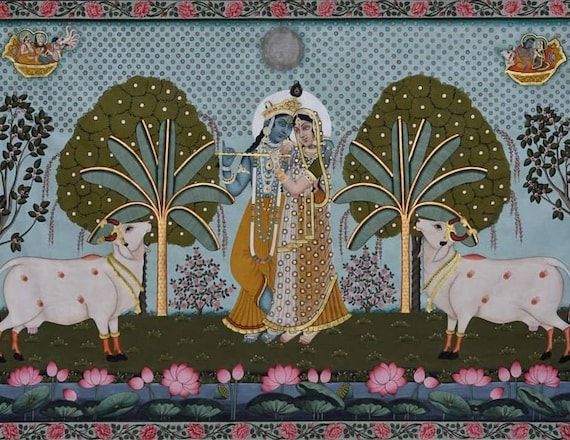Pichhwai: Art of Devotion

Pichhwai art is a traditional painting style that comes from Rajasthan, India. It is deeply connected to the worship of Lord Krishna, one of the most important gods in Hinduism. The word Pichhwai comes from the Sanskrit word pichh, meaning "back," because these paintings were usually displayed on the back walls of temples, especially in Nathdwara, a town famous for its Krishna temple. This art is not just beautiful but also has spiritual meaning, with a history that spans many centuries.
The Origins of Pichhwai Art
Pichhwai art started around the 16th century during the rule of the Mewar dynasty in Rajasthan. It became especially popular in Nathdwara, where the Shreenathji Temple is located. People created these paintings to decorate the temple during religious ceremonies and festivals. Over time, Pichhwai paintings became more detailed and focused on telling the stories of Lord Krishna’s life.
The paintings are linked to the Vaishnavism tradition, which worships Lord Vishnu, and more specifically, his incarnation as Krishna. They celebrate Krishna’s various roles — as a playful child, a lover, and a protector — showing his connection with nature and spirituality. These paintings were not only for decoration but also used during worship, helping devotees feel closer to the divine.
Key Features of Pichhwai Art
Themes and Imagery: Pichhwai paintings often focus on Lord Krishna and his life. Popular themes include Krishna’s childhood in Vrindavan, his playful moments with Radha and the Gopis (his female devotees), and his miracles like lifting the Govardhan Hill. Krishna is usually shown with his flute, surrounded by animals, peacocks, and cows, which represent his close connection with nature. The love between Krishna and Radha symbolizes the bond between the divine and the human soul.
Color and Technique: Pichhwai art is known for its bright colors. Artists use natural dyes made from plants, minerals, and other natural materials. Common colors include red, yellow, blue, green, and gold. Blue represents Krishna’s divinity, and gold highlights his sacred presence. These colors are carefully chosen to create depth and beauty, making the paintings appear lifelike and spiritually powerful.
The paintings are also known for their detailed work. The backgrounds often include floral patterns, geometric designs, and scenes from nature, which give the artwork a sense of divine beauty and harmony.
Use of Gold Leaf: A special feature of Pichhwai art is the use of gold leaf. Gold is applied to specific parts of the painting, like Krishna’s crown or his radiant form, to emphasize his divine qualities. The gold adds a shimmering effect that makes the painting look sacred and beautiful.
The Process of Creating Pichhwai Paintings
Creating Pichhwai paintings is a careful and detailed process. Artists start by preparing the cloth on which they will paint. The cloth is stretched and treated so that it can hold the paint properly. After sketching the main design, the artist fills it in with natural dyes. The fine details, such as Krishna’s expressions and the decorations, are painted with small brushes for precision.
Gold leaf is applied to certain areas to highlight important elements. This process requires a lot of patience and skill, ensuring that the painting is both beautiful and meaningful.
Cultural and Religious Significance
Pichhwai paintings have deep religious meaning. They are not just artwork but are used in temple rituals, especially in places like Nathdwara. These paintings are often changed during different seasons or for festivals like Janmashtami, which celebrates Krishna’s birth. Each painting tells a story or shows an important event from Krishna’s life, helping devotees focus on their worship and connect with Krishna.
The paintings also reflect Krishna’s connection to nature, love, and spirituality. By looking at these works, devotees are reminded of Krishna’s divine qualities, such as love, compassion, and wisdom.
The Revival and Future of Pichhwai Art
Recently, there has been renewed interest in Pichhwai art, both in India and around the world. Artists are working to keep the traditional techniques alive while also incorporating new ideas. Some modern artists have added their own styles to Pichhwai paintings, ensuring that the art continues to be appreciated by younger generations.
Many people, including art collectors and religious followers, are drawn to Pichhwai art for its beauty and spiritual depth. Efforts are being made to preserve this ancient art through workshops, art schools, and museums, so that future generations can continue to enjoy and learn from it.
Pichhwai art is a beautiful and meaningful form of painting that has been part of India’s spiritual and cultural history for centuries. Through its bright colors, detailed designs, and depictions of Lord Krishna, Pichhwai art helps connect people with the divine. Whether in temples or in homes, these paintings invite people to reflect on Krishna’s qualities and inspire devotion. As this art continues to evolve, it remains a powerful expression of faith, beauty, and cultural heritage.